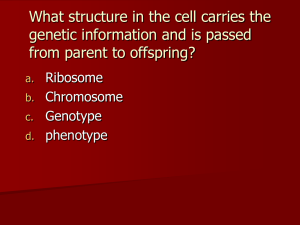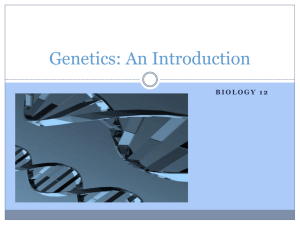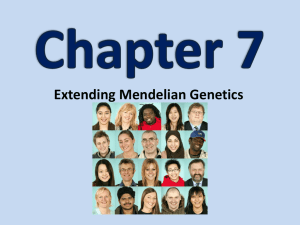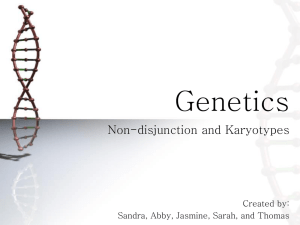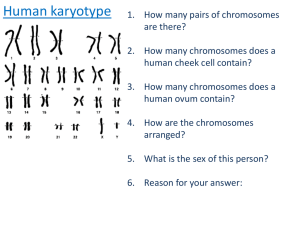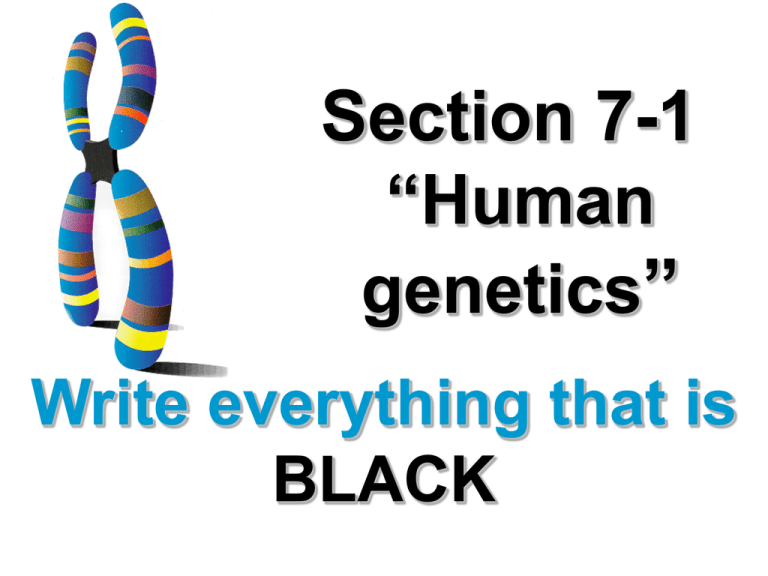
Section 7-1
“Human
genetics”
Write everything that is
BLACK
7.1 Human Genetics (Chromosomes and Phenotype)
KEY CONCEPT
The chromosomes on which genes are located can
affect the expression of traits
7.1 Human Genetics (Chromosomes and Phenotype)
Two copies of each gene affect phenotype
• Mendel studied
autosomal (body
cell) gene traits,
like hair texture
7.1 Human Genetics (Chromosomes and Phenotype)
• Mendel’s rules of inheritance apply to
autosomal genetic disorders.
– A heterozygote for a recessive disorder is a carrier
– Disorders caused by dominant alleles are
uncommon
(dominant)
7.1 Human Genetics (Chromosomes and Phenotype)
Males and females can differ in sex-linked traits
• Genes on sex chromosomes are called sex-linked
genes
– Y chromosome genes in mammals are
responsible for male characteristics
– X chromosome genes in
mammals affect many traits
7.1 Human Genetics (Chromosomes and Phenotype)
Our chromosomes:
• Recall …
• In humans the diploid number of
chromosomes is 46 (23 pairs)
• 22 pairs of homologous (matching)
chromosomes called autosomes
• The 23rd pair are sex chromosomes
7.1 Human Genetics (Chromosomes and Phenotype)
Sex Chromosomes:
• Females are XX
–Have 2 X chromosomes that are
alike
• Males are XY
–Have 1 X and 1 Y chromosome
The Y chromosome is smaller (just
says be a male)
7.1 Human Genetics (Chromosomes and Phenotype)
• Males have an XY genotype
–All of a male’s
sex-linked
genes are
expressed
–Males have no
second copies
of sex-linked
genes
7.1 Human Genetics (Chromosomes and Phenotype)
• Females have an XX genotype
– Expression of sex-linked genes is similar
to autosomal genes in females
– X chromosome inactivation randomly
“turns off” one X chromosome
7.1 Human Genetics (Chromosomes and Phenotype)
• After meiosis there are
gametes (sperm or egg cells)
that each have only one
chromosome
• All female eggs will have one X
• All males will have half their
sperm with X chromosomes
and half with Y
7.1 Human Genetics (Chromosomes and Phenotype)
•Now write
everything on the
next slide for your
genetics book …
“How a zygote is made as
male or female”
Female XX
Eggs
XX
girl
X
X
XX
girl
50 % chance of a girl
Male XY
X
XY
boy
Y
Sperm
XY
boy
50% chance of a boy
7.1 Human Genetics (Chromosomes and Phenotype)
Problems …
• Nondisjunction: The
failure of homologous
chromosomes to separate
properly during meiosis
• This can happen in the
autosomes or sex
chromosomes
7.1 Human Genetics (Chromosomes and Phenotype)
• If one homologous pair fails to
separate, half of the sex cells
produced will have one too many
chromosomes while the other half
has one less chromosome
• Trisomy: has one too
many chromosomes
7.1 Human Genetics (Chromosomes and Phenotype)
• When an extra chromosome is at
#21 the result is Down Syndrome
• This person will have 47
chromosomes instead of 46.
These are in the autosomes (not
sex cells)
• People with Down Syndrome
usually survive, but will have
mental retardation
7.1 Human Genetics (Chromosomes and Phenotype)
• Monosomy: one less
chromosome
• These organisms
usually do not survive
(except in Turner’s
Syndrome)
7.1 Human Genetics (Chromosomes and Phenotype)
• When 2 gametes with an
extra set of chromosomes
fuse we it is called polyploidy
• Its rare in animals and results
in death
• It is seen frequently in plants.
Flowers and fruits tend to be
bigger and plants healthier
7.1 Human Genetics (Chromosomes and Phenotype)
• True hermaphrodites
(both male and female
organs) are very rare
and are not caused by
abnormal chromosome
numbers
7.1 Human Genetics (Chromosomes and Phenotype)
• There are many X-linked traits like:
• Muscular Dystrophy, colorblindness
• These are more prevalent in males
because they don’t have another
normal X to cover up the bad one


